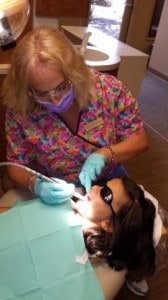It is recommended that your child go to his or her first child dentistry visit around age three. This first visit to the dentist takes only a small amount of time and it involves little (if any) treatment.

We may suggest that you hold your child on your lap in the dental chair while we perform the examination. You could also be requested to wait in the waiting area for part of your child's visit so Dr. Frey can build a professional relationship with her or him.
We will perform an exam on your child's gums and teeth with great care not to hurt him or her. X-rays could also be performed to uncover any decay and to discover how your child's permanent teeth are forming down in the gum area. We might need to clean the teeth and do an application of topical fluoride to the teeth to protect them from decay. You also will be asked if your child is getting enough fluoride on a regular basis at home. We will also go over the proper way for you to take care of your son's or daughter's teeth.

Want to learn more about pediatric dentistry and how to prepare for your child's first dental visits? Click here.
Helpful Tips for Your Child's First Visit
"What do I need to explain to my son or daughter about this first visit to the dentist?" Parents often ask us this question. We recommend that you offer a similar explanation to your child to that of going to the shoe store or hairstylist for the first time. You may just be pleasantly surprised at your child's reaction to this first dental visit.
- 1. Make a special trip to the office to give your child a preview before the day of the appointment.
- 2. Read stories to your child about visiting the dentist.
- 3. Tell your child what will happen at the dentist before attending the first dentist.
- 4. Talk about your own experiences with the dentist in a pleasant way.
- 5. Remember that Dr. Frey will examine the child's mouth, gums, and teeth. He will explain problematic behaviors for the teeth such as thumb sucking. Dr. Frey will also evaluate your child's need for fluoride. He will show you how to clean your child's gums and teeth properly.
- 6. At the end of the appointment, Dr. Frey will recommend a specific schedule for dental visits on a routine basis.
What is Preventative Care?
Children and tooth decay do not go hand in hand as they once did. Our office highly focuses on preventative care for your child's teeth. We apply the latest sealant on your child's teeth to prevent cavities. A dental sealant is 'space-age' plastic and it is bonded onto the chewing surfaces of your child's back teeth, as these are at higher risk of decaying than the front teeth are. This is an important step in starting your child on the right path to ideal oral care for his or her mouth, gums, and teeth.
Prevention of Cavities
 Cavities often occur because improper brushing and a high amount of sugar intake. The correct brushing methods and limiting the amount of sugar will help to prevent some of the cavities. When your child needs to chew his or her food for a long period of time, the longer the food residue is in contact with the teeth. This increase the risk of cavities.
Cavities often occur because improper brushing and a high amount of sugar intake. The correct brushing methods and limiting the amount of sugar will help to prevent some of the cavities. When your child needs to chew his or her food for a long period of time, the longer the food residue is in contact with the teeth. This increase the risk of cavities.
Each time anyone consumes food, it causes an acid reaction to happen in the mouth as bacteria starts to digest any sugars. It takes about 20 minutes for this reaction to subside. This acid reaction could harm the structure of the teeth and lead to cavities eventually.
The consistency of the saliva a person has does make a difference. When the saliva is thin, it breaks down more quickly and rinses the food faster from the teeth. A diet high is sugars and carbohydrates creates thicker saliva in a person's mouth and produces more acid-producing bacteria to form to cause cavities.
Cavity-Prevention Tips
- 1. Limit the number of snacks and meals throughout the day.
- 2. Encourage frequent flossing, brushing and rinsing.
- 3. Have your child drink more non-sugary drinks than sugary ones.
- 4. Limit the amount of sticky foods that your child eats.
- 5. Make special treats just another part of a meal.
- 6. Serve your child only nutritious snacks.
The first teeth to form in a baby's mouth are the front two bottom teeth. This will happen at around 6 to 8 months of age. The next teeth to appear are the 4 front upper teeth. Then the other teeth show up through the skin periodically. These typically show up in pairs on one side or other of the mouth. This stops around age of 2 1/2 years old.
You child will most likely have all of his or her teeth by around this age. The first of the permanent teeth come in at around 5 to 6 years of age. Most of the permanent teeth replace the baby teeth. However, some do not. Do not be alarmed if some of the teeth come in early or late compared to this time frame, as this could vary from child to child.
Baby teeth have more than one duty. They hold the space that the permanent teeth need, along with being important for speech, appearance, biting, and chewing. This is why it is crucial that your child have ideal child dentistry hygiene and a healthy daily diet.




